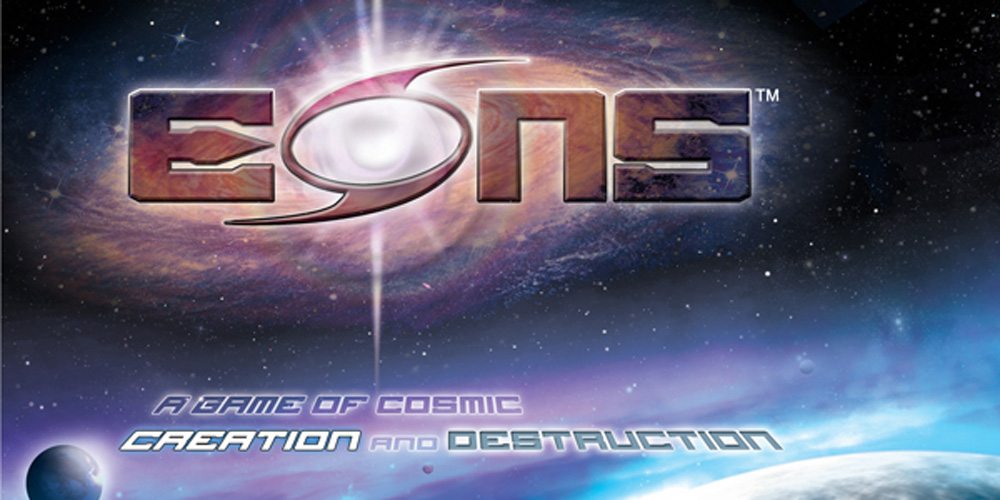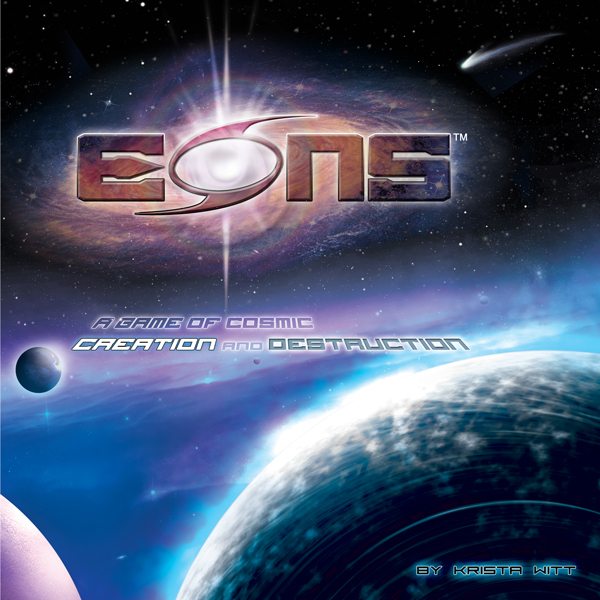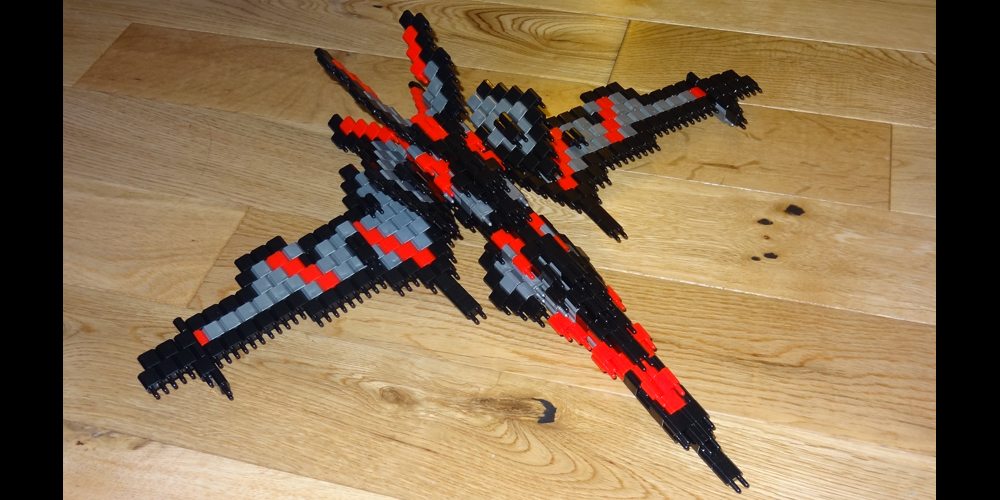Eons is a game about creating stars and planets from a few basic elements … and destroying them with supernovas and black holes. It was funded through Kickstarter last year and released during the summer by Gamer Nation Studios, and I first came across the game at Gen Con. Gamer Nation Studios (which also published Edition Wars) just launched another Kickstarter campaign today for a set of three expansions to the game, so I thought I’d tell you about the base game so you know how it works.
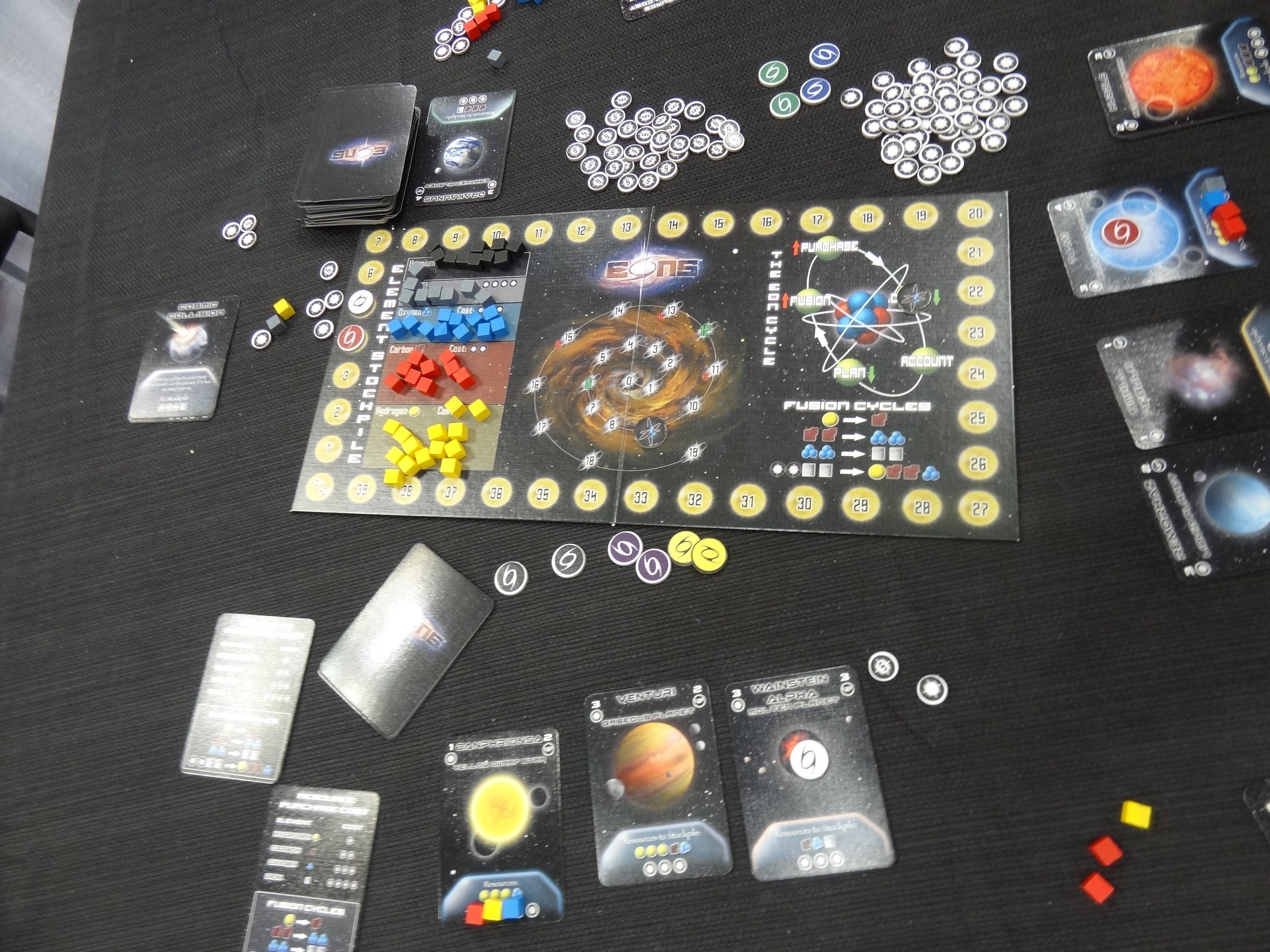
Eons is for 2 to 4 players, ages 14 and up, and takes about 90 minutes to play. I would say you could go a little younger on the age range, but the game does require some multi-stage planning ahead which can get complex even for adults. It retails for $34.99.
Components
The game comes with:
- 1 game board
- 90 resource cubes
- 145 Cosmos cards
- 14 Player tokens
- 96 Essence tokens
- 2 tracking tokens
- 5 reference cards
Although the game is for up to 5 players, there are 7 player colors because the publisher decided to include extras in black and white for higher contrast, which may be better for color blind players. The quality of the components isn’t spectacular, but is pretty nice. I thought the Essence tokens (the basic currency of the game) were a little small, but at least they’re thick enough to be pretty easy to pick up.
The whole thing comes in a square box that is a little smaller than your typical game box, which is nice— I always appreciate a game that doesn’t make itself as large as possible. The rules are printed on a single large sheet that is folded up, which isn’t the easiest for looking things up, but it works all right.
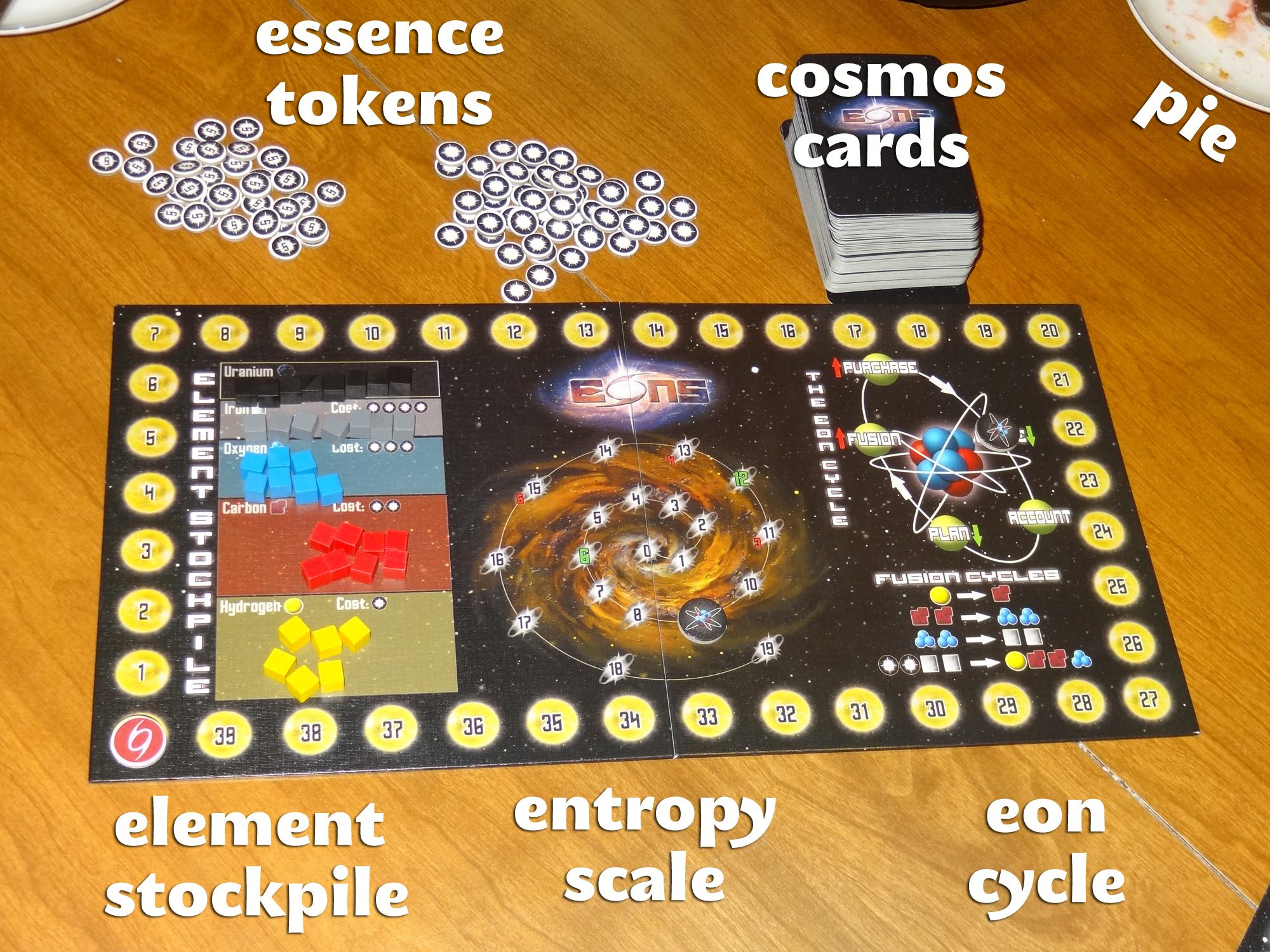
How to Play
Note: the base game rules are available as a PDF here, and you can also download the variant cooperative scenarios as a PDF.
The goal of the game is to have the most victory points when the entropy of the universe reaches zero. However, unlike some games in which victory points are cumulative, in Eons your victory points are a snapshot of what you currently have in your section of the cosmos. If planets or stars are destroyed, you may lose points. Also: the entropy decreases whenever a planet or star is destroyed, so the length of the game depends on how aggressively everyone is playing.
All the Cosmos cards are shuffled together and everyone gets 7 cards. You also start with a few elements (4 Hydrogen, 3 Carbon, 2 Oxygen, and 1 Iron), plus 10 Essence tokens, which represents your will or power and is a basic currency of the game. You’ll start with some number of each element in the stockpile on the board based on the number of players, and the entropy marker is placed on the scale (the spiral in the center of the board) where denoted by the number of players. The Eon Cycle marker starts on the Create phase.
The game goes in a cycle of phases: Create, Account, Plan, Fusion, and Purchase, with the turn order going either from last place to first place or vice versa (as indicated on the cycle track).
Create lets you spend elements and Essence to create planets, stars, and other heavenly bodies. Elements spent for planets go back to the stockpile, and elements spent to create stars are placed on the star card itself, where they’ll be used later for Fusion. There are also things like Supernova, Cosmic Collisions, and Black Holes, which can be used to destroy things (yours or an opponent’s).
In the Account phase, you add up victory points for all of the cards in front of you, and mark your position on the scoring track. Each star can support a certain number of planets—if you have too many planets, the excess planets do not score any points. You’ll also collect Essence tokens based on the cards you have in front of you. Finally, the players’ positions on the scoring track will determine the turn order for the next round of play.
Plan is simple: discard any number of cards from your hand, then draw back up to 7 cards.
Fusion is a key part of the game: the stars undergo fusion (or sometimes fission), and the elements on a star are transmuted into other elements. Each star can undergo multiple fusion cycles, but only with the elements that it started with—the newly created elements are placed on the center of the card and cannot be used until later. If a star is unable to undergo fusion because it doesn’t have the right elements or because the resulting elements are unavailable in the stockpile, then the star dies, and the owner takes a uranium element. At the end of Fusion, you may take any of the newly created elements into your resource pool (for creating new things), or leave them on the star card for future Fusion phases.
Purchase is when you may buy elements directly from the stockpile by spending Essence. It costs more than using Fusion to generate the elements you need, but it’s faster.
And then you go back to Create again.
When the Entropy Marker reaches zero, you play through one more Account phase, and then whoever has the highest score at that point wins the game.

The Verdict
Eons has some pretty fun mechanics to it—especially the way that fusion works for the stars. When you first create a star, the elements go onto the star card itself, and during each Fusion phase you must transmute elements. Afterward, you can take the newly transmuted elements from the star into your resource pool for creating other things, or you can return them to the star for future fusion.
The trick is that you’ll have to plan ahead—if you start taking out too many resources or you don’t leave the right combination in your star, then your star will die when the next Fusion phase rolls around. For most stars, you can sustain them indefinitely by leaving most of the resources there—but then you’re not producing things to spend. It can be a delicate balance between the short term and long term benefits.
And then, of course, your opponent might come along and destroy your star with a supernova or black hole anyway, so all those resources you’ve been saving up on your star are lost. Should’ve spent them while you had the chance.
The Entropy track is also an interesting component, because it only moves when something is destroyed—so if everyone is playing nice, the game can go on longer, allowing everyone to generate more Essence, buy more resources, and create more things … at least until the element stockpile runs out because all the elements are spread out across a bunch of stars. If there’s a lot of attacking early on, though, then the game can end more quickly before players have had a chance to build up. It also allows for the strategy to run down the clock quickly if you feel you’ve got enough points to win.
It’s not a game with a built-in catch-up mechanic, though, which is more evident in the two-player game. If you get ahead on production, you’ll have more points, generate more Essence, allowing you to buy more elements to create more planets, which puts you further ahead in production. At that point, the other player’s main recourse is to destroy your stuff—but that requires spending their Essence and elements on destruction rather than building, and it runs the clock down. In a three- or four-player game, it’s more likely that the leaders will be attacking each other, giving the others a chance to build up in the meantime. I haven’t played it enough yet to see if there’s a good way to tilt the balance in a two-player game, but I might just recommend sticking with at least three (or playing the cooperative modes for two).
Eons is ultimately about building an engine that generates resources (and points), and that requires good planning and a bit of luck in your card draws. Deciding which stars you want to sustain and which you can harvest for elements, and being careful about when you spend resources on creation or destruction—those are key decisions that you make throughout the game. If you like that sort of planning and resource-management, Eons is worth trying out. If you get a headache trying to keep track of how many Carbon to set aside for your Red Giant Star and how much Essence you can spend on additional Hydrogen and wait stop talking I lost count … then Eons might not be the game for you.
I haven’t tried the cooperative scenarios yet, but they look like they could be fun and tense, as you’re trying to accumulate a set number of victory points before the universe collapses.

The Kickstarter for Eons: Cosmic Expansions just launched today. You can back for just the expansions, or also get the base game if you missed it the first time around. The expansions add new ways to destroy things, additional types of stars and planets (including verdant planets which already have life on them), and even advanced civilizations which can develop their own technology like space travel. I should be receiving a prototype to try out soon, so I’ll try to report back after I’ve tried those out.
For more about the expansions, visit the Kickstarter page.
Disclosure: GeekDad received a review copy of the base game.
